Analysis of Leadership Styles and Organizational Structure at Tesco
VerifiedAdded on 2022/12/15
|8
|2278
|177
Report
AI Summary
This report delves into the realm of leadership management, using Tesco as a case study to illustrate various leadership styles and their impact on organizational structure. It begins by defining leadership and its significance in guiding subordinates towards common goals, emphasizing the interplay between organizational culture and structure. The main body of the report explores different leadership styles, including autocratic, authoritative, democratic, coaching, affirmative, pacesetting, and laissez-faire, and analyzes their suitability within an organizational context. The report also examines Tesco's adoption of the democratic leadership style and its hierarchical organizational structure, detailing the roles and responsibilities within the workforce and the flow of information. Furthermore, it explores the interrelation between organizational structure and culture, highlighting their mutual influence on company growth, employee interaction, and the attainment of organizational goals. The report also touches upon employment law, specifically the Equality Act of 2010, emphasizing the importance of equal opportunities and non-discrimination in the workplace. The conclusion summarizes the key findings, reinforcing the significance of effective leadership, organizational structure, and compliance with employment laws in fostering a positive and productive work environment.
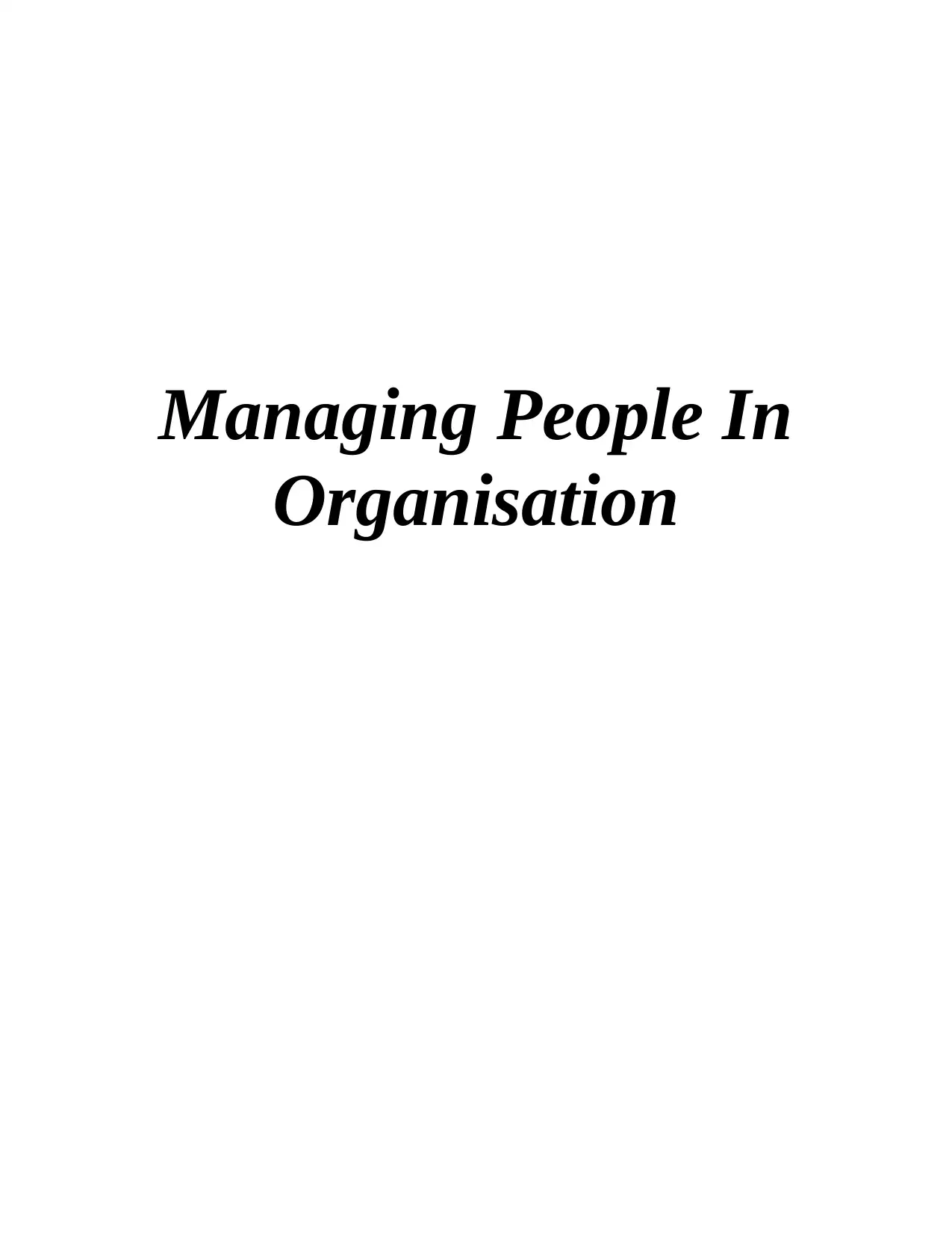
Managing People In
Organisation
Organisation
Paraphrase This Document
Need a fresh take? Get an instant paraphrase of this document with our AI Paraphraser
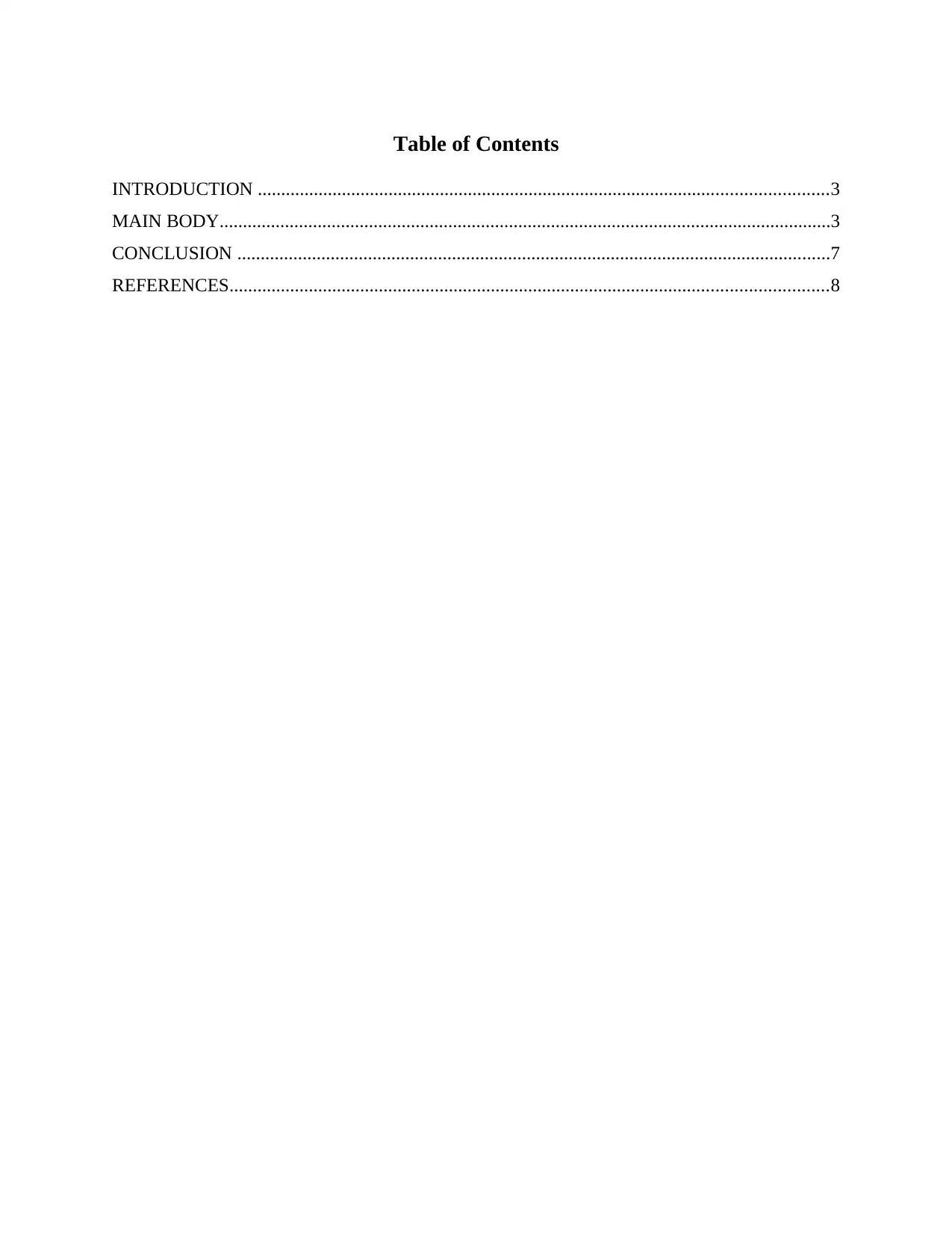
Table of Contents
INTRODUCTION ..........................................................................................................................3
MAIN BODY...................................................................................................................................3
CONCLUSION ...............................................................................................................................7
REFERENCES................................................................................................................................8
INTRODUCTION ..........................................................................................................................3
MAIN BODY...................................................................................................................................3
CONCLUSION ...............................................................................................................................7
REFERENCES................................................................................................................................8
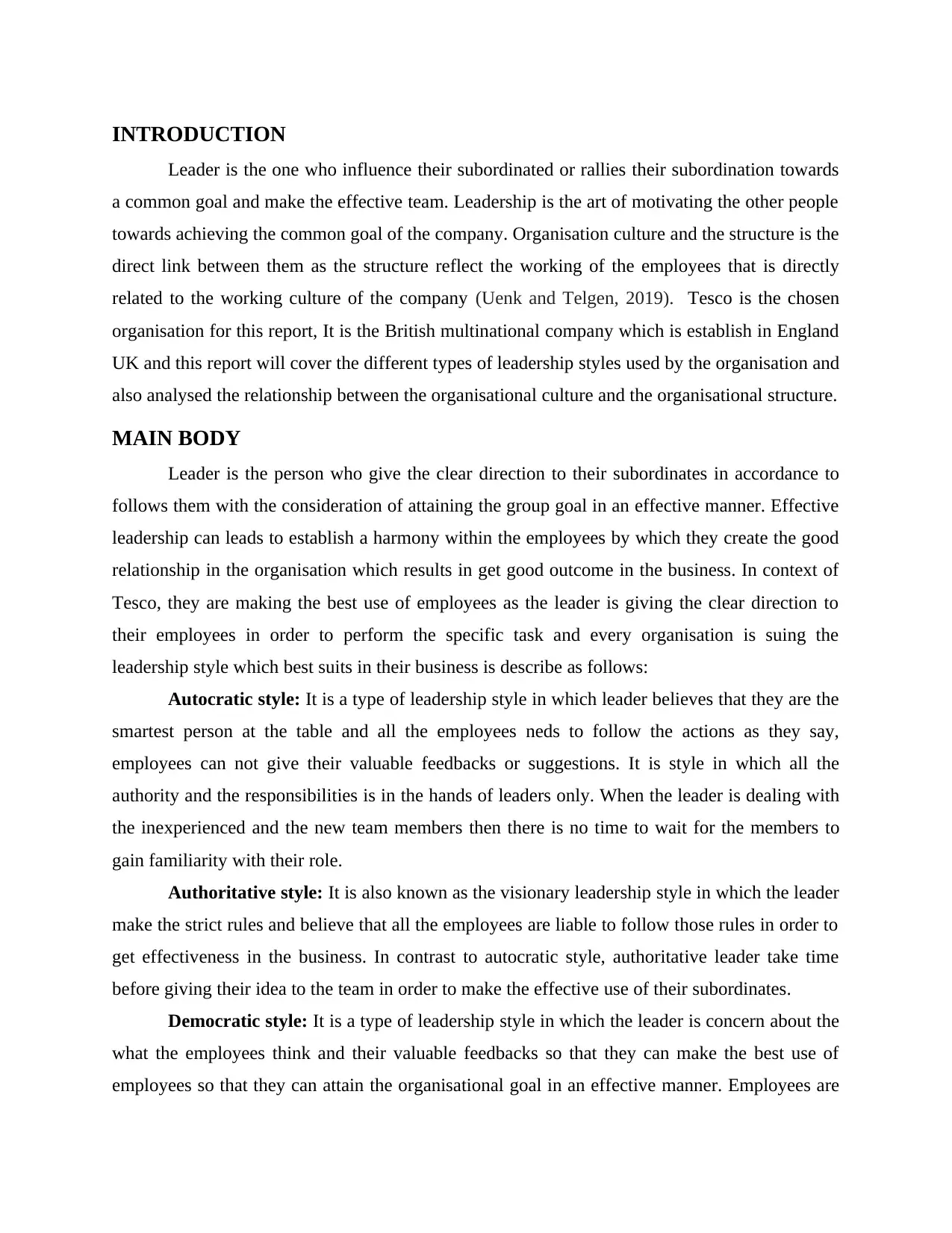
INTRODUCTION
Leader is the one who influence their subordinated or rallies their subordination towards
a common goal and make the effective team. Leadership is the art of motivating the other people
towards achieving the common goal of the company. Organisation culture and the structure is the
direct link between them as the structure reflect the working of the employees that is directly
related to the working culture of the company (Uenk and Telgen, 2019). Tesco is the chosen
organisation for this report, It is the British multinational company which is establish in England
UK and this report will cover the different types of leadership styles used by the organisation and
also analysed the relationship between the organisational culture and the organisational structure.
MAIN BODY
Leader is the person who give the clear direction to their subordinates in accordance to
follows them with the consideration of attaining the group goal in an effective manner. Effective
leadership can leads to establish a harmony within the employees by which they create the good
relationship in the organisation which results in get good outcome in the business. In context of
Tesco, they are making the best use of employees as the leader is giving the clear direction to
their employees in order to perform the specific task and every organisation is suing the
leadership style which best suits in their business is describe as follows:
Autocratic style: It is a type of leadership style in which leader believes that they are the
smartest person at the table and all the employees neds to follow the actions as they say,
employees can not give their valuable feedbacks or suggestions. It is style in which all the
authority and the responsibilities is in the hands of leaders only. When the leader is dealing with
the inexperienced and the new team members then there is no time to wait for the members to
gain familiarity with their role.
Authoritative style: It is also known as the visionary leadership style in which the leader
make the strict rules and believe that all the employees are liable to follow those rules in order to
get effectiveness in the business. In contrast to autocratic style, authoritative leader take time
before giving their idea to the team in order to make the effective use of their subordinates.
Democratic style: It is a type of leadership style in which the leader is concern about the
what the employees think and their valuable feedbacks so that they can make the best use of
employees so that they can attain the organisational goal in an effective manner. Employees are
Leader is the one who influence their subordinated or rallies their subordination towards
a common goal and make the effective team. Leadership is the art of motivating the other people
towards achieving the common goal of the company. Organisation culture and the structure is the
direct link between them as the structure reflect the working of the employees that is directly
related to the working culture of the company (Uenk and Telgen, 2019). Tesco is the chosen
organisation for this report, It is the British multinational company which is establish in England
UK and this report will cover the different types of leadership styles used by the organisation and
also analysed the relationship between the organisational culture and the organisational structure.
MAIN BODY
Leader is the person who give the clear direction to their subordinates in accordance to
follows them with the consideration of attaining the group goal in an effective manner. Effective
leadership can leads to establish a harmony within the employees by which they create the good
relationship in the organisation which results in get good outcome in the business. In context of
Tesco, they are making the best use of employees as the leader is giving the clear direction to
their employees in order to perform the specific task and every organisation is suing the
leadership style which best suits in their business is describe as follows:
Autocratic style: It is a type of leadership style in which leader believes that they are the
smartest person at the table and all the employees neds to follow the actions as they say,
employees can not give their valuable feedbacks or suggestions. It is style in which all the
authority and the responsibilities is in the hands of leaders only. When the leader is dealing with
the inexperienced and the new team members then there is no time to wait for the members to
gain familiarity with their role.
Authoritative style: It is also known as the visionary leadership style in which the leader
make the strict rules and believe that all the employees are liable to follow those rules in order to
get effectiveness in the business. In contrast to autocratic style, authoritative leader take time
before giving their idea to the team in order to make the effective use of their subordinates.
Democratic style: It is a type of leadership style in which the leader is concern about the
what the employees think and their valuable feedbacks so that they can make the best use of
employees so that they can attain the organisational goal in an effective manner. Employees are
⊘ This is a preview!⊘
Do you want full access?
Subscribe today to unlock all pages.

Trusted by 1+ million students worldwide
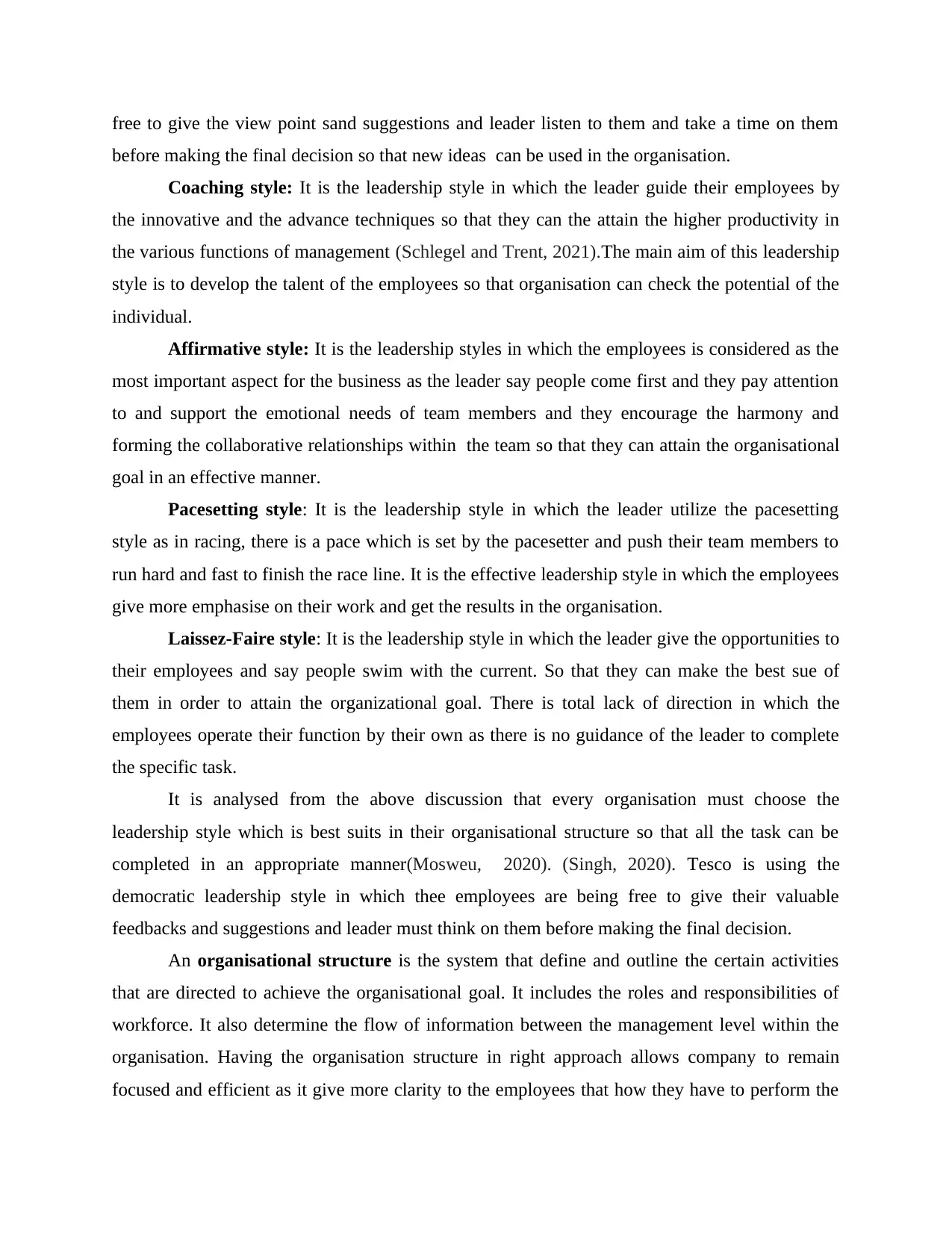
free to give the view point sand suggestions and leader listen to them and take a time on them
before making the final decision so that new ideas can be used in the organisation.
Coaching style: It is the leadership style in which the leader guide their employees by
the innovative and the advance techniques so that they can the attain the higher productivity in
the various functions of management (Schlegel and Trent, 2021).The main aim of this leadership
style is to develop the talent of the employees so that organisation can check the potential of the
individual.
Affirmative style: It is the leadership styles in which the employees is considered as the
most important aspect for the business as the leader say people come first and they pay attention
to and support the emotional needs of team members and they encourage the harmony and
forming the collaborative relationships within the team so that they can attain the organisational
goal in an effective manner.
Pacesetting style: It is the leadership style in which the leader utilize the pacesetting
style as in racing, there is a pace which is set by the pacesetter and push their team members to
run hard and fast to finish the race line. It is the effective leadership style in which the employees
give more emphasise on their work and get the results in the organisation.
Laissez-Faire style: It is the leadership style in which the leader give the opportunities to
their employees and say people swim with the current. So that they can make the best sue of
them in order to attain the organizational goal. There is total lack of direction in which the
employees operate their function by their own as there is no guidance of the leader to complete
the specific task.
It is analysed from the above discussion that every organisation must choose the
leadership style which is best suits in their organisational structure so that all the task can be
completed in an appropriate manner(Mosweu, 2020). (Singh, 2020). Tesco is using the
democratic leadership style in which thee employees are being free to give their valuable
feedbacks and suggestions and leader must think on them before making the final decision.
An organisational structure is the system that define and outline the certain activities
that are directed to achieve the organisational goal. It includes the roles and responsibilities of
workforce. It also determine the flow of information between the management level within the
organisation. Having the organisation structure in right approach allows company to remain
focused and efficient as it give more clarity to the employees that how they have to perform the
before making the final decision so that new ideas can be used in the organisation.
Coaching style: It is the leadership style in which the leader guide their employees by
the innovative and the advance techniques so that they can the attain the higher productivity in
the various functions of management (Schlegel and Trent, 2021).The main aim of this leadership
style is to develop the talent of the employees so that organisation can check the potential of the
individual.
Affirmative style: It is the leadership styles in which the employees is considered as the
most important aspect for the business as the leader say people come first and they pay attention
to and support the emotional needs of team members and they encourage the harmony and
forming the collaborative relationships within the team so that they can attain the organisational
goal in an effective manner.
Pacesetting style: It is the leadership style in which the leader utilize the pacesetting
style as in racing, there is a pace which is set by the pacesetter and push their team members to
run hard and fast to finish the race line. It is the effective leadership style in which the employees
give more emphasise on their work and get the results in the organisation.
Laissez-Faire style: It is the leadership style in which the leader give the opportunities to
their employees and say people swim with the current. So that they can make the best sue of
them in order to attain the organizational goal. There is total lack of direction in which the
employees operate their function by their own as there is no guidance of the leader to complete
the specific task.
It is analysed from the above discussion that every organisation must choose the
leadership style which is best suits in their organisational structure so that all the task can be
completed in an appropriate manner(Mosweu, 2020). (Singh, 2020). Tesco is using the
democratic leadership style in which thee employees are being free to give their valuable
feedbacks and suggestions and leader must think on them before making the final decision.
An organisational structure is the system that define and outline the certain activities
that are directed to achieve the organisational goal. It includes the roles and responsibilities of
workforce. It also determine the flow of information between the management level within the
organisation. Having the organisation structure in right approach allows company to remain
focused and efficient as it give more clarity to the employees that how they have to perform the
Paraphrase This Document
Need a fresh take? Get an instant paraphrase of this document with our AI Paraphraser
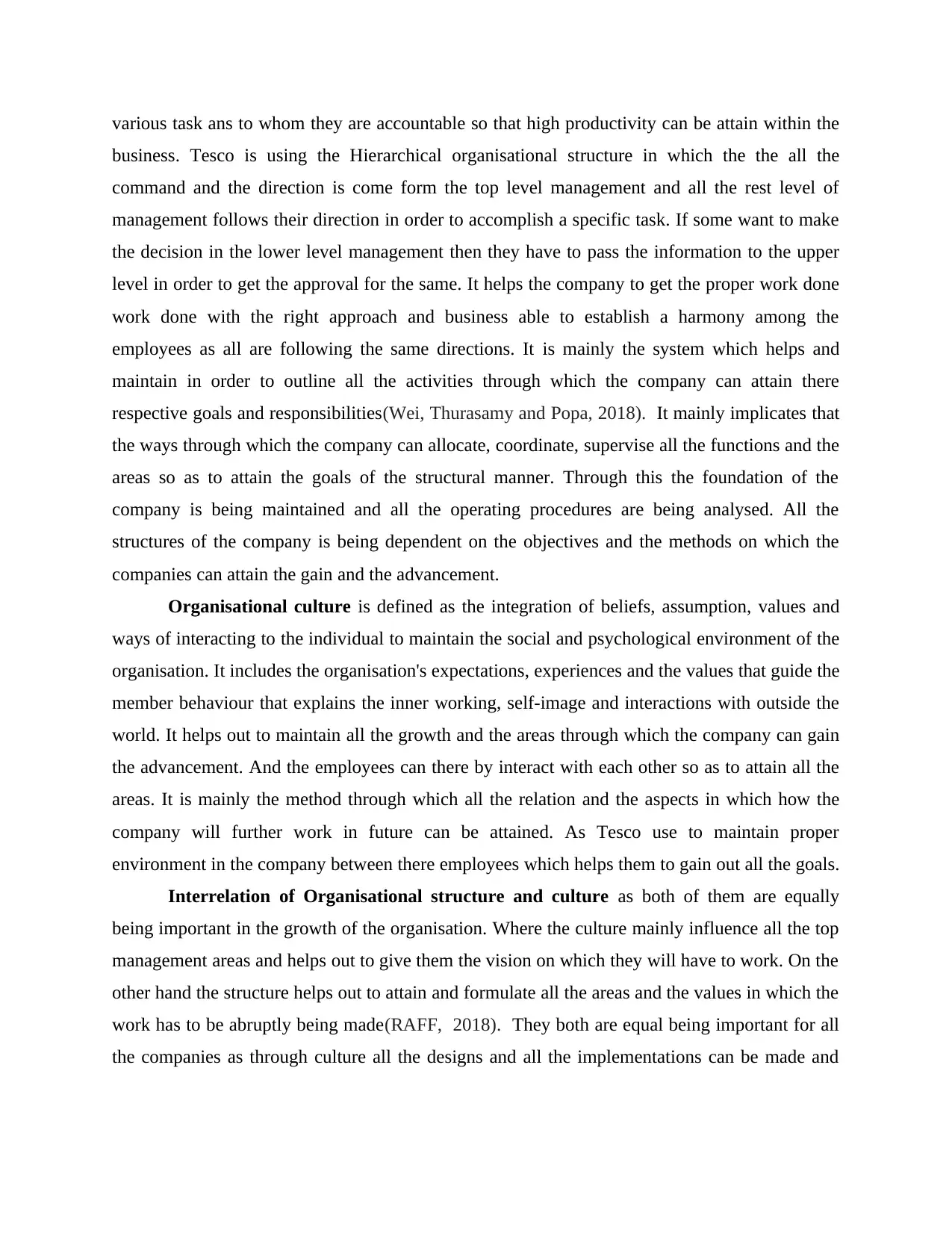
various task ans to whom they are accountable so that high productivity can be attain within the
business. Tesco is using the Hierarchical organisational structure in which the the all the
command and the direction is come form the top level management and all the rest level of
management follows their direction in order to accomplish a specific task. If some want to make
the decision in the lower level management then they have to pass the information to the upper
level in order to get the approval for the same. It helps the company to get the proper work done
work done with the right approach and business able to establish a harmony among the
employees as all are following the same directions. It is mainly the system which helps and
maintain in order to outline all the activities through which the company can attain there
respective goals and responsibilities(Wei, Thurasamy and Popa, 2018). It mainly implicates that
the ways through which the company can allocate, coordinate, supervise all the functions and the
areas so as to attain the goals of the structural manner. Through this the foundation of the
company is being maintained and all the operating procedures are being analysed. All the
structures of the company is being dependent on the objectives and the methods on which the
companies can attain the gain and the advancement.
Organisational culture is defined as the integration of beliefs, assumption, values and
ways of interacting to the individual to maintain the social and psychological environment of the
organisation. It includes the organisation's expectations, experiences and the values that guide the
member behaviour that explains the inner working, self-image and interactions with outside the
world. It helps out to maintain all the growth and the areas through which the company can gain
the advancement. And the employees can there by interact with each other so as to attain all the
areas. It is mainly the method through which all the relation and the aspects in which how the
company will further work in future can be attained. As Tesco use to maintain proper
environment in the company between there employees which helps them to gain out all the goals.
Interrelation of Organisational structure and culture as both of them are equally
being important in the growth of the organisation. Where the culture mainly influence all the top
management areas and helps out to give them the vision on which they will have to work. On the
other hand the structure helps out to attain and formulate all the areas and the values in which the
work has to be abruptly being made(RAFF, 2018). They both are equal being important for all
the companies as through culture all the designs and all the implementations can be made and
business. Tesco is using the Hierarchical organisational structure in which the the all the
command and the direction is come form the top level management and all the rest level of
management follows their direction in order to accomplish a specific task. If some want to make
the decision in the lower level management then they have to pass the information to the upper
level in order to get the approval for the same. It helps the company to get the proper work done
work done with the right approach and business able to establish a harmony among the
employees as all are following the same directions. It is mainly the system which helps and
maintain in order to outline all the activities through which the company can attain there
respective goals and responsibilities(Wei, Thurasamy and Popa, 2018). It mainly implicates that
the ways through which the company can allocate, coordinate, supervise all the functions and the
areas so as to attain the goals of the structural manner. Through this the foundation of the
company is being maintained and all the operating procedures are being analysed. All the
structures of the company is being dependent on the objectives and the methods on which the
companies can attain the gain and the advancement.
Organisational culture is defined as the integration of beliefs, assumption, values and
ways of interacting to the individual to maintain the social and psychological environment of the
organisation. It includes the organisation's expectations, experiences and the values that guide the
member behaviour that explains the inner working, self-image and interactions with outside the
world. It helps out to maintain all the growth and the areas through which the company can gain
the advancement. And the employees can there by interact with each other so as to attain all the
areas. It is mainly the method through which all the relation and the aspects in which how the
company will further work in future can be attained. As Tesco use to maintain proper
environment in the company between there employees which helps them to gain out all the goals.
Interrelation of Organisational structure and culture as both of them are equally
being important in the growth of the organisation. Where the culture mainly influence all the top
management areas and helps out to give them the vision on which they will have to work. On the
other hand the structure helps out to attain and formulate all the areas and the values in which the
work has to be abruptly being made(RAFF, 2018). They both are equal being important for all
the companies as through culture all the designs and all the implementations can be made and
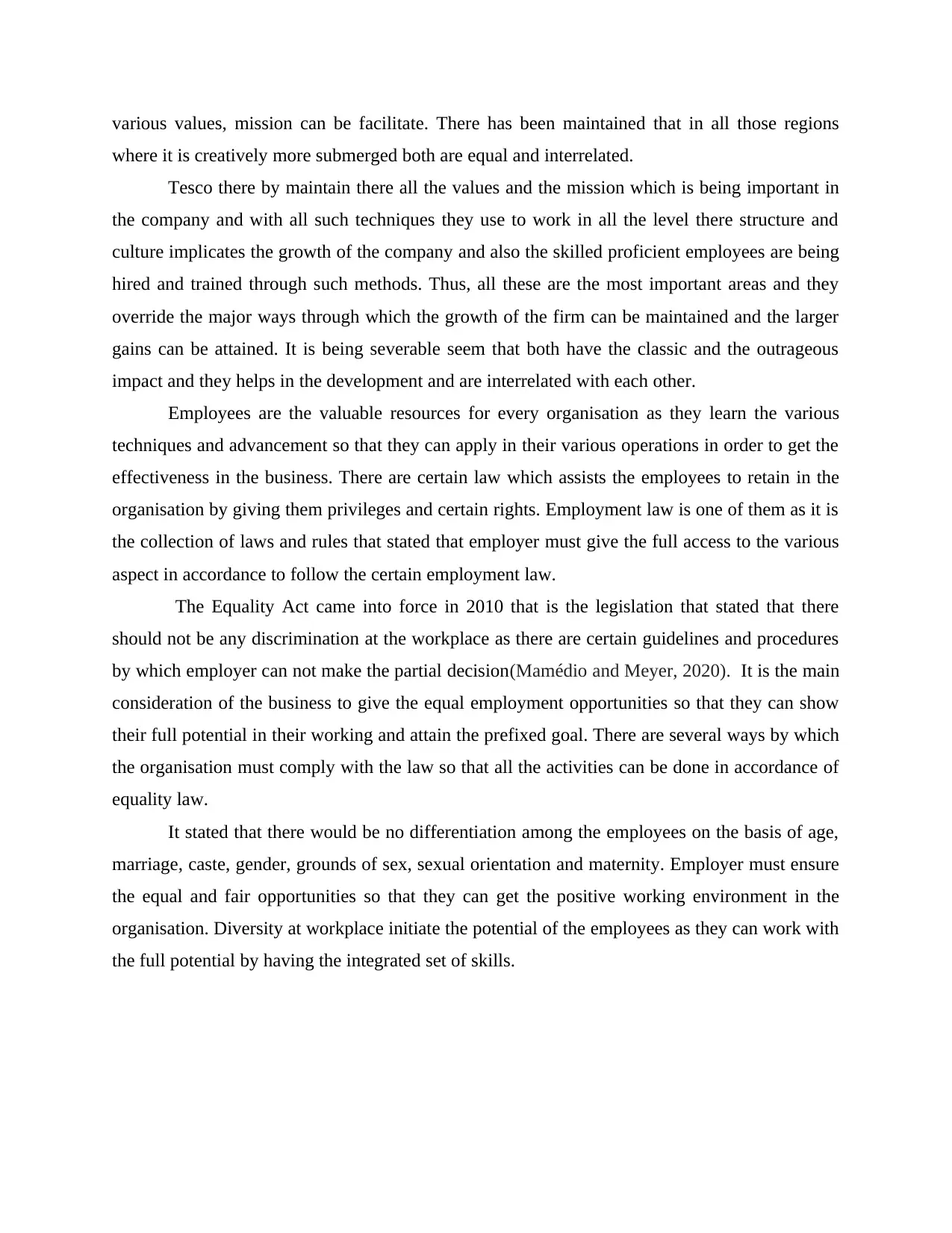
various values, mission can be facilitate. There has been maintained that in all those regions
where it is creatively more submerged both are equal and interrelated.
Tesco there by maintain there all the values and the mission which is being important in
the company and with all such techniques they use to work in all the level there structure and
culture implicates the growth of the company and also the skilled proficient employees are being
hired and trained through such methods. Thus, all these are the most important areas and they
override the major ways through which the growth of the firm can be maintained and the larger
gains can be attained. It is being severable seem that both have the classic and the outrageous
impact and they helps in the development and are interrelated with each other.
Employees are the valuable resources for every organisation as they learn the various
techniques and advancement so that they can apply in their various operations in order to get the
effectiveness in the business. There are certain law which assists the employees to retain in the
organisation by giving them privileges and certain rights. Employment law is one of them as it is
the collection of laws and rules that stated that employer must give the full access to the various
aspect in accordance to follow the certain employment law.
The Equality Act came into force in 2010 that is the legislation that stated that there
should not be any discrimination at the workplace as there are certain guidelines and procedures
by which employer can not make the partial decision(Mamédio and Meyer, 2020). It is the main
consideration of the business to give the equal employment opportunities so that they can show
their full potential in their working and attain the prefixed goal. There are several ways by which
the organisation must comply with the law so that all the activities can be done in accordance of
equality law.
It stated that there would be no differentiation among the employees on the basis of age,
marriage, caste, gender, grounds of sex, sexual orientation and maternity. Employer must ensure
the equal and fair opportunities so that they can get the positive working environment in the
organisation. Diversity at workplace initiate the potential of the employees as they can work with
the full potential by having the integrated set of skills.
where it is creatively more submerged both are equal and interrelated.
Tesco there by maintain there all the values and the mission which is being important in
the company and with all such techniques they use to work in all the level there structure and
culture implicates the growth of the company and also the skilled proficient employees are being
hired and trained through such methods. Thus, all these are the most important areas and they
override the major ways through which the growth of the firm can be maintained and the larger
gains can be attained. It is being severable seem that both have the classic and the outrageous
impact and they helps in the development and are interrelated with each other.
Employees are the valuable resources for every organisation as they learn the various
techniques and advancement so that they can apply in their various operations in order to get the
effectiveness in the business. There are certain law which assists the employees to retain in the
organisation by giving them privileges and certain rights. Employment law is one of them as it is
the collection of laws and rules that stated that employer must give the full access to the various
aspect in accordance to follow the certain employment law.
The Equality Act came into force in 2010 that is the legislation that stated that there
should not be any discrimination at the workplace as there are certain guidelines and procedures
by which employer can not make the partial decision(Mamédio and Meyer, 2020). It is the main
consideration of the business to give the equal employment opportunities so that they can show
their full potential in their working and attain the prefixed goal. There are several ways by which
the organisation must comply with the law so that all the activities can be done in accordance of
equality law.
It stated that there would be no differentiation among the employees on the basis of age,
marriage, caste, gender, grounds of sex, sexual orientation and maternity. Employer must ensure
the equal and fair opportunities so that they can get the positive working environment in the
organisation. Diversity at workplace initiate the potential of the employees as they can work with
the full potential by having the integrated set of skills.
⊘ This is a preview!⊘
Do you want full access?
Subscribe today to unlock all pages.

Trusted by 1+ million students worldwide
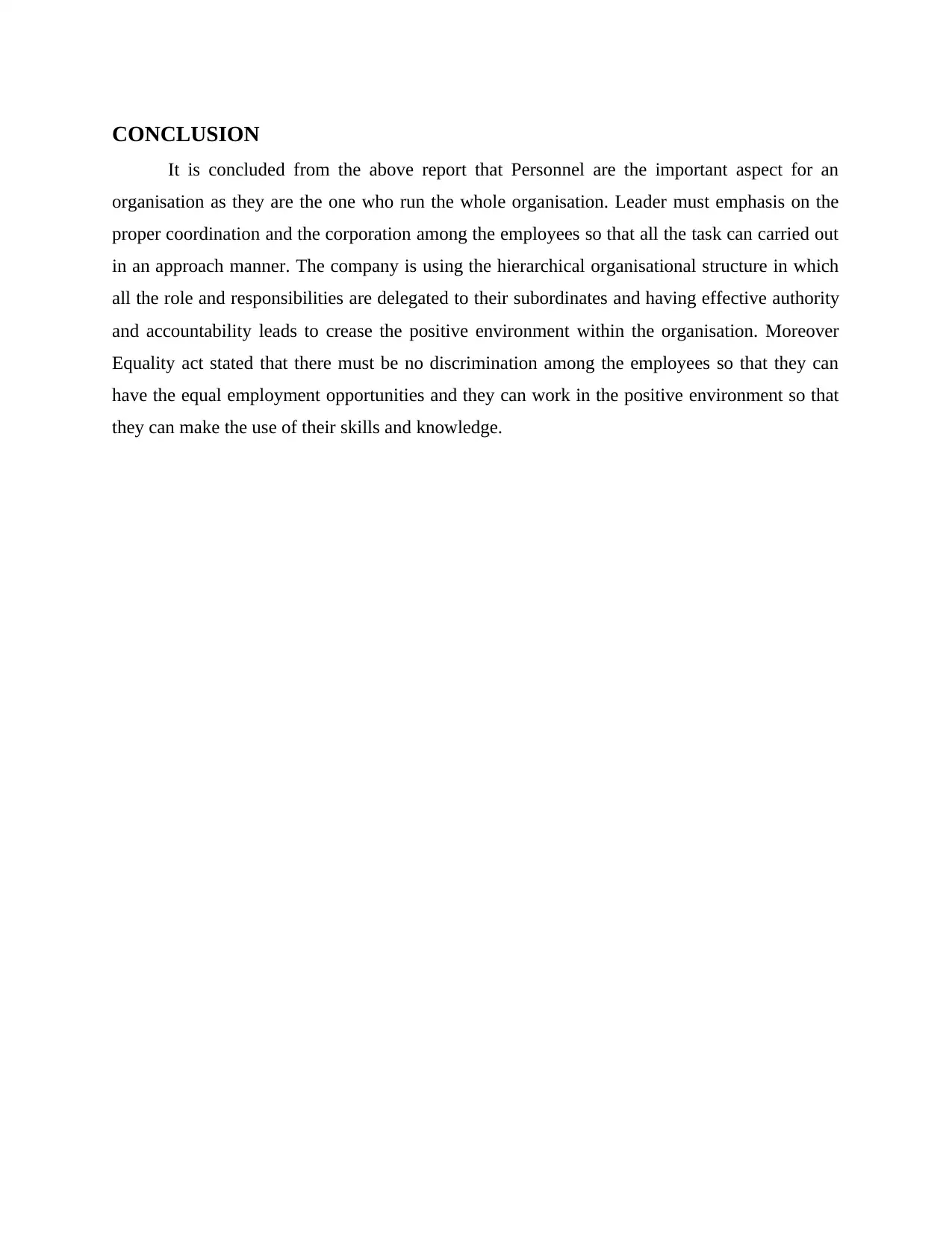
CONCLUSION
It is concluded from the above report that Personnel are the important aspect for an
organisation as they are the one who run the whole organisation. Leader must emphasis on the
proper coordination and the corporation among the employees so that all the task can carried out
in an approach manner. The company is using the hierarchical organisational structure in which
all the role and responsibilities are delegated to their subordinates and having effective authority
and accountability leads to crease the positive environment within the organisation. Moreover
Equality act stated that there must be no discrimination among the employees so that they can
have the equal employment opportunities and they can work in the positive environment so that
they can make the use of their skills and knowledge.
It is concluded from the above report that Personnel are the important aspect for an
organisation as they are the one who run the whole organisation. Leader must emphasis on the
proper coordination and the corporation among the employees so that all the task can carried out
in an approach manner. The company is using the hierarchical organisational structure in which
all the role and responsibilities are delegated to their subordinates and having effective authority
and accountability leads to crease the positive environment within the organisation. Moreover
Equality act stated that there must be no discrimination among the employees so that they can
have the equal employment opportunities and they can work in the positive environment so that
they can make the use of their skills and knowledge.
Paraphrase This Document
Need a fresh take? Get an instant paraphrase of this document with our AI Paraphraser
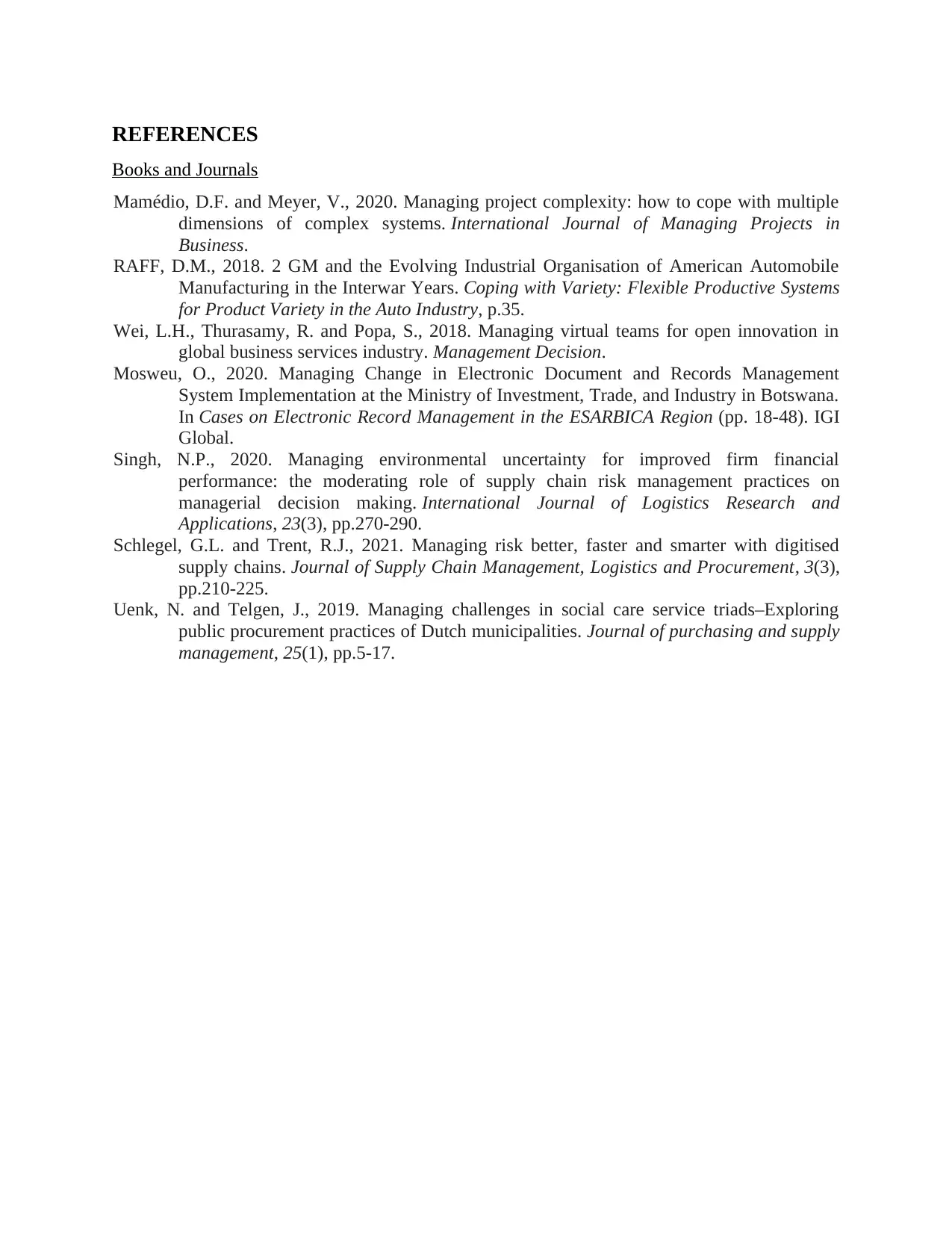
REFERENCES
Books and Journals
Mamédio, D.F. and Meyer, V., 2020. Managing project complexity: how to cope with multiple
dimensions of complex systems. International Journal of Managing Projects in
Business.
RAFF, D.M., 2018. 2 GM and the Evolving Industrial Organisation of American Automobile
Manufacturing in the Interwar Years. Coping with Variety: Flexible Productive Systems
for Product Variety in the Auto Industry, p.35.
Wei, L.H., Thurasamy, R. and Popa, S., 2018. Managing virtual teams for open innovation in
global business services industry. Management Decision.
Mosweu, O., 2020. Managing Change in Electronic Document and Records Management
System Implementation at the Ministry of Investment, Trade, and Industry in Botswana.
In Cases on Electronic Record Management in the ESARBICA Region (pp. 18-48). IGI
Global.
Singh, N.P., 2020. Managing environmental uncertainty for improved firm financial
performance: the moderating role of supply chain risk management practices on
managerial decision making. International Journal of Logistics Research and
Applications, 23(3), pp.270-290.
Schlegel, G.L. and Trent, R.J., 2021. Managing risk better, faster and smarter with digitised
supply chains. Journal of Supply Chain Management, Logistics and Procurement, 3(3),
pp.210-225.
Uenk, N. and Telgen, J., 2019. Managing challenges in social care service triads–Exploring
public procurement practices of Dutch municipalities. Journal of purchasing and supply
management, 25(1), pp.5-17.
Books and Journals
Mamédio, D.F. and Meyer, V., 2020. Managing project complexity: how to cope with multiple
dimensions of complex systems. International Journal of Managing Projects in
Business.
RAFF, D.M., 2018. 2 GM and the Evolving Industrial Organisation of American Automobile
Manufacturing in the Interwar Years. Coping with Variety: Flexible Productive Systems
for Product Variety in the Auto Industry, p.35.
Wei, L.H., Thurasamy, R. and Popa, S., 2018. Managing virtual teams for open innovation in
global business services industry. Management Decision.
Mosweu, O., 2020. Managing Change in Electronic Document and Records Management
System Implementation at the Ministry of Investment, Trade, and Industry in Botswana.
In Cases on Electronic Record Management in the ESARBICA Region (pp. 18-48). IGI
Global.
Singh, N.P., 2020. Managing environmental uncertainty for improved firm financial
performance: the moderating role of supply chain risk management practices on
managerial decision making. International Journal of Logistics Research and
Applications, 23(3), pp.270-290.
Schlegel, G.L. and Trent, R.J., 2021. Managing risk better, faster and smarter with digitised
supply chains. Journal of Supply Chain Management, Logistics and Procurement, 3(3),
pp.210-225.
Uenk, N. and Telgen, J., 2019. Managing challenges in social care service triads–Exploring
public procurement practices of Dutch municipalities. Journal of purchasing and supply
management, 25(1), pp.5-17.
1 out of 8
Related Documents
Your All-in-One AI-Powered Toolkit for Academic Success.
+13062052269
info@desklib.com
Available 24*7 on WhatsApp / Email
![[object Object]](/_next/static/media/star-bottom.7253800d.svg)
Unlock your academic potential
Copyright © 2020–2025 A2Z Services. All Rights Reserved. Developed and managed by ZUCOL.




